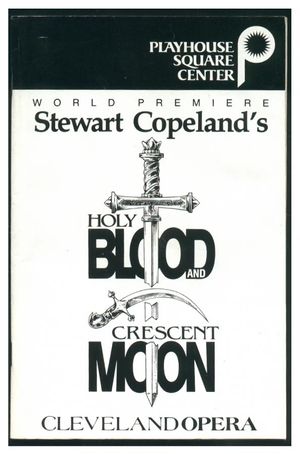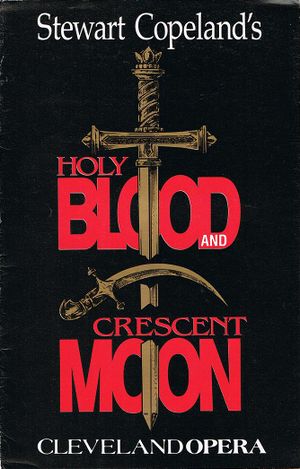Difference between revisions of "Holy Blood and Crescent Moon"
m (→Performance history) |
m |
||
| Line 7: | Line 7: | ||
|- style="background-color: #f9f9f9;" | |- style="background-color: #f9f9f9;" | ||
| colspan="2" | [[Image:holy_blood_booklet.jpg|thumb|center|promotional booklet for this opera]] | | colspan="2" | [[Image:holy_blood_booklet.jpg|thumb|center|promotional booklet for this opera]] | ||
| + | [[Image:holy_blood_flyer.jpg|thumb|center|promotional flyer for this opera]] | ||
|- style="background-color: #E6E6E6;" | |- style="background-color: #E6E6E6;" | ||
! colspan="2" | Basic information | ! colspan="2" | Basic information | ||
Revision as of 02:22, 9 September 2011
| Holy Blood and Crescent Moon | |
|---|---|
| Basic information | |
| Composed by: | Stewart Copeland |
| Composed in: | 1989 |
| Length: | XX minutes |
| Premiere date: | 1989-10-10 |
| Premiere venue: | State Theatre |
| Premiere location: | Cleveland, OH, USA |
Contents
Introduction
Opening statement: Please insert a brief statement about this composition. For television scores, use Template:Television (score) instead of this template. For film scores, use Template:Film (score) instead of this template. In some cases, Template:Song will fit better, or some combination of these two templates. Please use your best judgment based on the recording and performance history of this composition.
Background
This section needs more information. Include an introduction to this composition: if it was commissioned for a particular event, based on a particular source material, other individuals involved in the production of this piece, etc.
Performance history
The opera was performed by two alternate casts between 1989-10-10 and 1989-10-15 (Cleveland, OH, USA - State Theatre).
It was also performed in Fort Worth, TX, USA - probably on 1990-11-16.
Release History
Holy Blood and Crescent Moon was never officially released in recorded format. However, the premiere performance was broadcast on public radio and recordings of it are in circulation.
Quotations and trivia
Information by performer Gary Davis:
"Cleveland Opera commissioned the work and it had it's world debut there. I believe the entire run was sold out. It later played in Texas - Houston Opera, I think - and possibly other areas of the world. This was Stewart's first opera, but I don't believe his only opera. I think there was another commision that might have been called Horseopera commisioned by possibly a London opera house, but my memory is really fuzzy on that.
Apparently the commission of Holy Blood and Crescent Moon came about when David Bamford (then director of Cleveland Opera) saw some TV interview with Stewart focussing on a ballet he was then scoring. At the end of the interview he was asked what next and he answered (apparently as just a joke), "Opera!" David's teenage son was watching the program with his dad at the time and freaked out basically spreading some of that enthusiasm to his dad and apparently that's how the seed got planted.
Stewart himself was actively involved in the production and I would see him regularly. Aside from myself, I don't know if anyone else in the production was aware of his post Police solo work and he was a bit surprised, pleasantly I hope, when I had him autograph stuff like Rumble Fish, The Rhythmatist, The Equalizer & Other Cliff Hangers, Animal Logic, etc. I found the opera score to be very much like the style of solo work at that time (excluding Animal Logic, of course). And music from a track from The Equalizer & Other Cliff Hangers - Tancred Ballet - was part of the opera. Tancred was the name of one of the characters. I remember him telling me that that CD was especially rare.
Also around were his fellow band members from Curved Air, Sonja Kristina (his wife at the time) and violinist Darryl Way who was assisting Stewart with the orchestrations. I managed to get his autograph on a copy of his Concerto for Electric Violin album at the cast party after the opening night. He was so shocked I had it that he took it for a while to show it to others!
During the opening night performance Stewart actually was part of one of the scenes leading the Muslim army raid on the Christian castle. In that scene I was one of the Christian knights and got kicked by Stewart as he stormed the castle. He only did this during the opening night and did not reprise that role during the Cleveland Opera run of it. As a member of the choir - I sang first tenor - I played both Christian and Muslim in different parts of the opera.
Overall, it was a lot of fun. Having been a fan of his solo work prior to the production, I found much to like in the music of the opera. We had costumes from Hollywood that had previously been used in the movie production of Camelot. And they had swords made from Toledo, Spain. There were intensely choreographed fight scenes (and I later saw our fight choreographer in some BBC production of the King Arthur legends). During fight practice I once got knocked in the head and another time had a lens knocked out of my glasses! LOL!
The music was recorded and played at least once on a local radio station - WKSU-FM. I still have two t-shirts and one jacket from the production. And I thnk I still have the program somewhere, too.
Overall I think it needs to be performed again. It's message of common people being dragged into war against their best interests by religious leaders seems much more topical today than it was then. And, for that matter, delving into the 'descendants of Jesus' bit is also much more topical today, thanks to Dan Brown, than it was then. Both Dan Brown and Stewart Copeland were very much influenced by the book, Holy Blood Holy Grail."
See also
This section needs more information.
External links
References
source: Gary Davis

